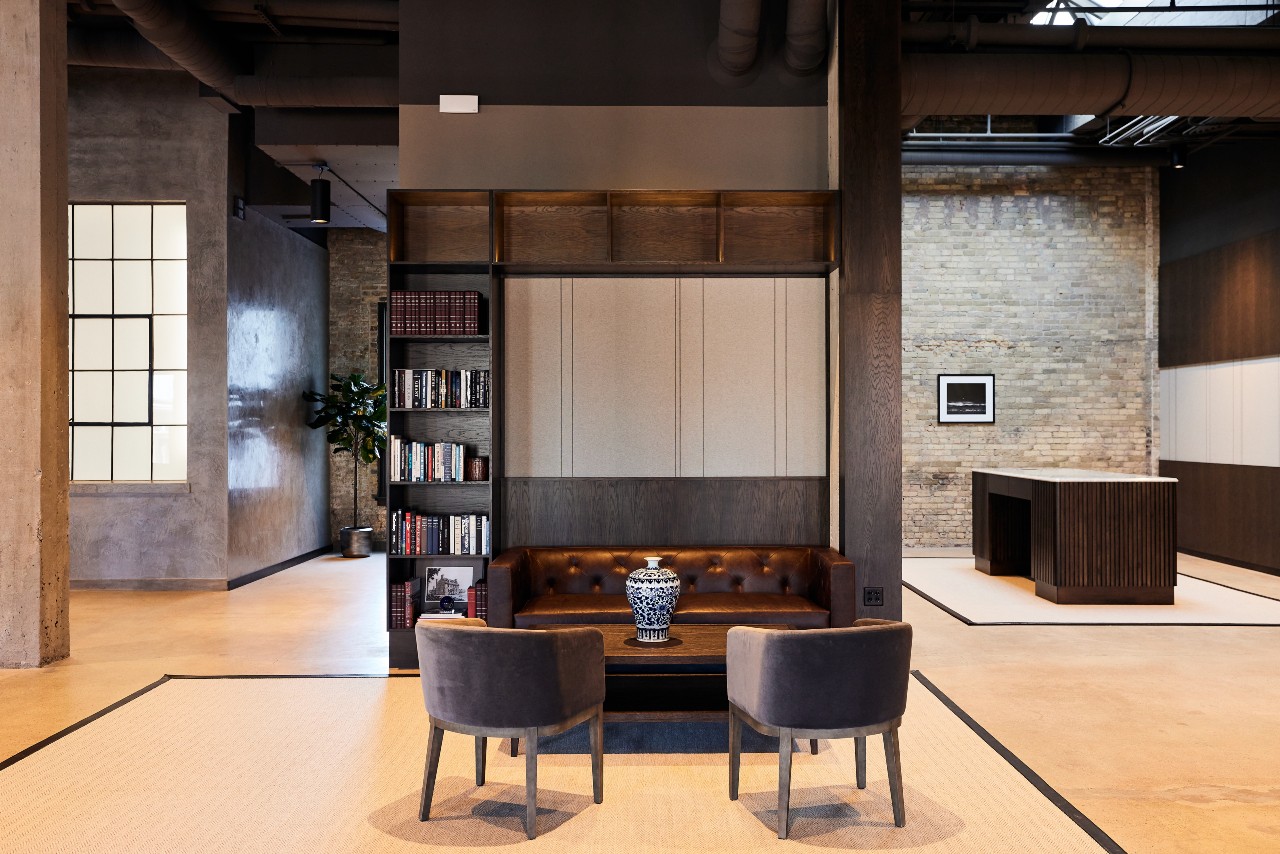At Shea, we pride ourselves on staying on top of what’s happening in design news so that you don’t have to—and we pull what’s smartest and most forward-thinking together to save you the time of sifting through it all. It helps us keep tabs on what’s fresh, inspiring, and happening in the world—and we make a few headlines of our own, too.
“The Crucial Role of Furniture in Hybrid Workplace Design” – Work Design:
In this Work Design piece, the “new rules” of the workplace are broken down—hybrid is here to stay, thinking must be fluid and offer choice, tech is the leader for work settings, and companies need to create a framework for successful employees—and applied to office design to put the workplace in line with employees’ new expectations. Whether it’s rethinking benching systems or abandoning the fully open office in favor of zones and agile separation elements, selecting the right furniture is an efficient solution to upgrade the overall office experience. Flexible furniture rooted in hospitality design makes for comfortable offices with multiple configurations, shapes, and levels of privacy, and the private office and conference room need to be rethought as well, based on their type and frequency of use.
“A Guide to Living Walls and Rooftop Gardens” – Restaurant Development + Design:
Biophilia continues to permeate restaurant design, and what are becoming known as “plant surfaces” are a great way to incorporate that notion into a restaurant with limited outdoor space. Rooftop gardening epitomizes hyper-local sourcing for restaurants, and living walls (AKA vertical gardens, green walls, living green walls, or eco walls) are panels of plants grown vertically using hydroponics (no soil required). Restaurant Development + Design looks at not only the health benefits of including this kind of biophilia in a traditionally urban setting, but also the aesthetic and installation considerations to take, along with a great overview of the types of systems and maintenance that operators will have to do.
“Banks Are Remaking Their Offices for the Hybrid Era, Complete with Cold Brew on Tap” – Financial Post:
Tech offices aren’t the only ones stepping up their workplace designs for the next generation of workers—Wall Street is getting in on the idea of bringing in new staples and perks that cater to what employees want in their spaces, and that’s often the kind of collaborative areas that aren’t traditional to financial firms. This article looks at how several New York offices have incorporated new values of wellness and brevity into recently acquired spaces to both provide extra perks and change up their office footprints for efficiency.
“Why Eatertainment is Going to Make a Major COVID Comeback” – FSR:
Eatertainment was a huge trend on the rise in 2019, and it’s coming back with aplomb this year. Operators are taking advantage of the guest desire to get out and have fun, and many eatertainment concepts include expansive outdoor areas—assuaging the worries of those still anxious about group gatherings. This piece looks at how several concepts are looking for a big post-pandemic rebound, with new ventilation systems and outdoor areas in place, better food offerings, real-life/analog games to combat screen fatigue, and big promises of fun to meet the pent-up demand.
“Hotels Refurbish to Take Advantage of More Guests Dining in Their Rooms” – Skift:
With some guests opting to spend more time in their hotel rooms than in the past (versus common areas or taking advantage of hotel restaurants and cafés), hoteliers are rethinking the furnishings and design of guest rooms to be more accommodating. Skift looks at these changes, noting that although many hotel restaurants have returned to pre-pandemic levels of business, in-room dining numbers have also risen. Many hotel chains are making major investments to improve the functionality of rooms, making remote work easier and more comfortable, with an easy transition to dining options. Orientation of furniture is being played with to make video calls look their best, and operations for hotel restaurants are being reconsidered to make for more seamless delivery to rooms—including everything from butler’s pantries to new ordering apps.
“The Roaring ’20s? A State of the Industry Report” – Restaurant Development + Design:
With its regular State of the Industry report, Restaurant Development + Design has sees a bright future for restaurants and hospitality spaces, despite that restaurant recovery is happening more slowly than operators hoped. The report addresses sales, labor, retail-grocery operations, and the “new normal,” predicting a decade of transformation and reinvention of restaurants. Technology and new generations of consumers mean that people are comfortable getting restaurant food in nontraditional ways, so off-premises plans are as important as dine-in. The piece includes interviews with restaurateurs and executives of major food brands as to what they’re focusing on for the decade ahead, and where they see the industry going.
“Why the ‘Connected Office’ Will Shape the Future of the Office Industry” – Forbes:
Forbes takes a look at the notion of the “connected office,” one that is part of the larger surrounding community. Employees want to be both physically and mentally connected to their surroundings, and this has an impact on landlords and designers. Building certifications through WELL, LEED, and Fitwel are almost mandatory for new and retrofitted buildings, as tenants look for landlords to go “outside the walls” of the office building to include amenities like walkability and greenspace, as well as community connections. They’re also looking for shared spaces to collaborate with their teammates and meet other tenants, and flexible spaces not only in common areas but in their own office suites as well.
“Shea Clients Stack the Star Tribune’s List of Iconic Twin Cities Dishes” – Shea:
The Star Tribune features local iconic dishes, with many Shea spots and clients called out as must-visits
“Competition Heats Up for Both Urban, Suburban Restaurant Space. But What About Business Districts?” – Business Journal:
The Business Journal digs into the latest real-estate trends in restaurants as new concepts begin to move into the 90,000 spaces that closed during the pandemic. Certain spaces are highly competitive—particularly in hip, on-the-rise urban neighborhoods and inner-ring suburbs. But central business districts are struggling to fill restaurant spaces as more companies embrace notions of hybrid work, meaning that downtowns will be overall emptier. Restaurants are changing their strategies, not only with where they’re putting locations, but who they’re trying to capture with their concepts. Even concepts that are traditionally reserved for “business” areas, such as steakhouses and seafood spots, are looking further out in the suburbs and finding stiff competition. All of these findings are related to changes in population trends as a result of the pandemic, as well as new notions of how consumers want to spend time and money. Finally, the piece looks at how tenant-improvement dollars are being impacted by these trends, and how landlords are inserting themselves further into restaurant deals in their buildings to protect their investments.
“The Return-to-Office is Both Divergent and Divisive. What Does That Mean for Design?” – Work Design:
The office market is back, and this story from Work Design explores how different approaches that companies are taking will impact design practices. Enticing workers back with a balance of work-area types and support for a hybrid environment is going to be important to clients, each of which will be looking for an individualized solution that best works for them and their employees. Different sectors of industry will require different kinds of attention as they look to utilize space differently—marketing and media, for example, have shifted more easily to flexible spaces than financial and law firms, and they’re looking for different features in their offices. Every business sector and company will have a different threshold for how quickly they’re willing and ready to progress, and designers need to feel out clients to help them adapt in the ways that are most beneficial to their companies.
April 8, 2022
Curated by Shea: April

